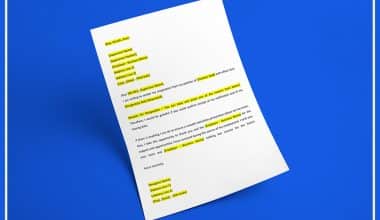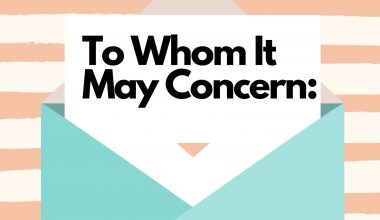Email has largely replaced many other forms of communication in today’s modern business. How you end an email can help you show professionalism, thoroughness, and an acceptable tone. Email closings usually take a lot of work to nail. There is more to those email closing phrases, conclusion phrases, and remarks than meets the eye. Hence, this article will discuss how to professionally end an email that requires a response and how to properly end an email to a professor.
How to End an Email
You certainly do not vanish into thin air, whether it was a phone call or a face-to-face chat afterward. Hence, you should close your email like any other interaction to leave a positive impression. Here are some ways to end an email.
#1. Draft a Closing Line
If you want feedback from the recipient of your email, the final line of the message should do more than just thank them for reading it. To end an email, you should include a call to action or remark that will either motivate or demonstrate that you expect feedback.
#2. Email Sign-off
A closing word, such as “regards,” is used to sign off at the end of an email. Conditional endings are the ideal way to end an email. Also, remember to follow it with a comma.
#3. Your Name
To end an email, you can omit your surname if you are on a first-name status with the receiver. However, in all other cases, it is preferable to provide your full name when introducing yourself. Ensure they remember you by signing off with your first and last name in any email correspondence.
It’s also recommended that you use your complete name in your email signature, portfolio, cover letter, and any other materials you submit for consideration.
#4. Include Your Professional Title
To end an email, use a title that describes what you do rather than your actual work title. For Instance, ” Sales Manager” instead of ” Sales Manager at LIB Company”).
#5. Add Your Contact Information
In this case, additional contact information, such as a direct phone number, must be included. Although the receiver may already be familiar with your email address. Thus, this is important while ending your email.
#6. Email Signature
To end an email, signatures are essential as they usually include your work title, company, and contact information, such as your phone number, website, and address. They are generally left out of email conversations.
What Is a Good Closing Word for an Email?
A formal closing word like “warm regards” is suitable for an email, but for a personal email, you can omit the closing entirely or add a term like “sincerely” before your autograph.
How To End an Email Professionally
Your inbox may be overflowing, yet you still take the time to send effective emails day after day. Then, when you’re finally at the end zone, panic will begin to set in. I mean, how the hell are you expected to determine the ideal closing for your official business emails? I’ve got you! Here are a few ways to end an email professionally:
#1. Use Your Full Name
Your email recipient is probably getting a lot of messages, and there’s a strong probability that some of them are from someone with the same first or last name as you. Hence, to end an email professionally, use your complete name to avoid misunderstanding with a colleague or client.
#2. Analyze Your Partnership With the Recipient
You should consider your relationship with the receiver before ending an email professionally. How intimate are your relationships? This can help you decide how formal your end should be. However, regardless of the connection, it’s essential to maintain your interaction at most semi-professional while using your work email.
#3. Include Your Contact Information
Depending on the nature of the conversation, you may need to move the discussion beyond email. In other words, to end an email professionally, you must include your contact information so that the recipient will know how to get in touch with you.
Also, keep your contact information ready just in case the person you’re emailing needs to reach you first.
#4. Avoid Unprofessional Language
Lastly, avoid using unprofessional language when concluding an email professionally. It is irrelevant whether your closest friends or coworkers use less professional language. Thus, adhering to more business-oriented phrasing will ensure that emails you compose beyond the subject do not inadvertently become overly casual.
How Do You End a Professional Email Example?
They include:
- Cordially
- Respectfully
- Best Regards
- All the Best
- Looking forward to hearing from you
- Best wishes
- Sincerely
- Thank you
- Kind regards
- Thank you so much for connecting!
What Is a Warm Way to End an Email?
They include:
- Warm regards
- Warmly
- Regards
- Warmest Regards
- Stay tuned
- Cordially
How To End an Email That Requires a Response
Here are ways to end an email that requires a response. They include:
#1. Employ Brief and Concise Closings
When it comes to closing out an email that demands a response, there are several approaches that may be used. No matter who the receiver is, you may use these tactics effectively. However, you must remember to keep the conclusions succinct and to the point at all times.
#2. Avoid Slangs
Even though email is a fast way to get in touch, it is still a very professional way to talk to coworkers and customers in a business setting. The professional nature of the topic you’re attempting to address is undermined in every way by using abbreviations, slang, and emoticons.
Thus, to end an email requiring a response, you must avoid all forms of slang.
#3. Always Check your grammar and spelling
It can’t be stressed enough how important it is to proofread before you end an email that requires a response. When you send an email that contains grammatical errors, it may immediately change how a coworker, supervisor, or customer perceives you. Also, if you make a mistake using the incorrect form of their, there, or they’re, your granny might forgive you, but a customer might cease hiring you to put together and update their newsletter.
However, before you end any email that requires a response, you should always do a last proofread and spend some time checking through them. You don’t want people to judge your expertise level because you occasionally use “to” instead of “too,” do you? Absolutely no!
#4. Avoid Jokes and Sarcasm
It is in everyone’s best interest to steer clear of this situation whenever possible since telling a joke in an email will never have the same effect as doing it in person. It is OK to be polite, but it is difficult to understand sarcasm or humor if the speaker does not use facial expressions or body language.
Hence, this is of the utmost importance when you want to end an email requiring a response. Predicting what will make other people laugh or offend them is impossible. So, be courteous, and reserve your jokes for face-to-face interactions.
#5. Offer Users a Diverse Range of Connectivity Options
To end an email that needs a reply, you need to make email signatures that give people different ways to interact with your brand on social media, websites, etc.
In addition, to establish brand awareness, you should hire a logo maker to produce a high-quality logo, express your company’s catchphrase, and so on.
#6. Endings Should Be Based on the Audience
When you want to end an email that requires a response. It should be tailored to the specific person or group you’re sending. Whether they’re new or returning business or consumer clients, colleagues in the workplace, or higher-ups in the company.
Just before you leave, you may want to see: Email Marketing Platforms: Overview and Common Features
Is Best regards a good closing?
Yes, the phrase “with best regards” is regularly used at the conclusion of emails as a kind sign-off. If an email ends with “with best regards,” it simply signifies that the sender sends their best wishes for your health and happiness. Also, it is an email ending considered semi-formal and can be used for personal and business correspondence.
How To End an Email To a Professor
Students who frequently need to communicate with their teachers about their schoolwork, upcoming deadlines, and research opportunities have the tricky issue of having to write professional emails.
When corresponding with their instructors through email, students frequently add a variety of essential components, such as welcomes, requests, and salutations. Reviewing a tutorial on how to correctly end an email to a professor is likely to be beneficial if you are a student who is now enrolled in school or who plans to enroll in school in the near future. In this piece, we will discuss the ways to end an email to a professor.
#1. Use Courteous Language to Make Your Expectations Known
To end an email to a professor, you should kindly reaffirm your expectations or request. If you do this, you can guarantee that you are clearly explaining what it is that you require from the professor as well as the reason that you are contacting him or her. Also, they will be able to get a good notion from this about the ways in which they may help you out as a student.
#2. You Can Propose a Face-To-Face Meeting for Further Discussion
When you have presented the professor with your objectives, you should consider scheduling a conference with them in order to go through everything in greater depth. If you think that a face-to-face meeting would be beneficial for both parties, you should ask for permission. It would also be considered courteous to suggest a time for the meeting that is inside their business hours or at a time that is convenient for them.
#3. Ensure to Express Your Appreciation to the Professor
At the end of the main body of the email, don’t forget to thank the professor for their time and convey your appreciation for it. If you want to make an impression that will remain, ensure to thank your professor for his or her time and assistance.
For Instance, maintaining your composure will be easier if you express thanks for the care shown to you when you make requests for accommodations, such as an extension on a deadline or time off from work.
#4. Use a Formal Salutation and Signature When Signing Off
To end an email to a professor professionally, you should close it with a courteous salutation such as “Best wishes” or “Sincerely.” You can sign your name and then follow it up with a professional email signature if you do so from this page. You can include your full name, the name of your school, any jobs you have right now, the type of degree you are trying to get, and the date you expect to graduate in your signature.
Over and Out
Email is an intriguing medium, particularly because it can be viewed as businesslike instant communication. Unless you’re sending a short email to your grandmother, it’s important to keep the content, language, and ending of your emails professional. There are countless ways to end an email, and we have listed the most prevalent ones. They are alternatives for changing the way you end an email while keeping it professional at all times. Try any of them, or try them all! and do let us know in the comment section.
How to End an Email FAQs
Yes, “warm regards” is usually used with close friends and family. It shouldn’t be used in business letters.
Best regards is a semi-formal letter that you employ at the end of the letter to express your best wishes to the reader. This type of sign-off is appropriate for both formal and informal situations.
References
- Instagantt.com
- hubspot.com
- forbes.com
- inkforall.com
Related Articles
- APPLY FOR COLLEGE GRANTS Simplified!!! A Comprehensive Guide
- BREAK EVEN CALCULATOR for Social Security and Mortgage (+ Best Options)
- 21+ Best Jobs in 2023 that Pay $40 an Hour With and Without a Degree
- Business Start Up from Scratch for Beginners (+ How-to-Start Guide)
- TO WHOM IT MAY CONCERN: All You Should Know!!!
- Email Marketing Platforms: Overview, Common Features, Comparisons
- HOW OLD DO YOU HAVE TO BE TO RENT A CAR?
- HOW TO WIN THE LOTTERY : Best Strategies In 2023






